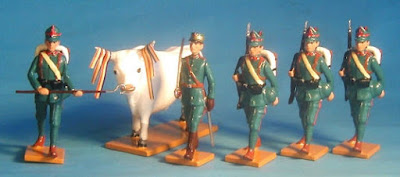United States: At the start of the war, President Woodrow Wilson declared a US policy of absolute neutrality, an official stance that would last until 1917 when Germany's policy of unrestricted submarine warfare forced them to enter the war on 6 April 1917. German submarine activity seriously threatened America's commercial shipping
As things stand at the moment Beau Geste don't produce any sets representing the fighting forces of the US
Japan: Honouring a military agreement with Britain Japan declared war on Germany on 23 August 1914 and two days later Austria-Hungary responded by declaring war on Japan
As is the case with the American forces Japan is currently unrepresented by any Beau Geste sets still in production although you may be lucky enough to get your hands on a couple of retired sets if you try
Italy: Although allied to both Germany and Austria-Hungary, Italy was able to avoid entering the fray in 1914 by citing a clause in their treaties. Italy was committed to defend Germany and Austria-Hungary only in the event of a 'defensive' war; arguing that her allies actions were 'offensive' she declared instead a policy of neutrality. The following year, in May 1915, she finally joined the conflict by siding with the Triple Entente
Beau Geste currently produce a number of Italian sets including the following
A Brief Timeline of the War
1914
Austrian Archduke Franz Ferdinand and his wife assassinated in Sarajevo by Serbian nationalist, Gavrilo Princip (June 28). Austria declares war on Serbia (July 28). Germany declares war on Russia (Aug. 1), on France (Aug. 3), invades Belgium (Aug. 4). Britain declares war on Germany (Aug. 4). Germans defeat Russians in Battle of Tannenberg on Eastern Front (Aug.). First Battle of the Marne (Sept.). German advance stopped 25 miles from Paris. By end of the year, the war on the Western Front has turned to one of stalemate and attrition and is being fought from a massive network of trenches
 |
| Belgian infantry..... |
 |
| .....and artillery |
 |
| German infantry |
1915
German submarine blockade of Great Britain begins (Feb.). Dardanelles Campaign—British land in Turkey (April), withdraw from Gallipoli (Dec.–Jan. 1916). Germans use gas at second Battle of Ypres (April–May). Lusitania sunk by German submarine—1,198 lost, including 128 Americans (May 7). On Eastern Front, German and Austrian “great offensive” conquers all of Poland and Lithuania; Russians lose 1 million men (by Sept. 6). “Great Fall Offensive” by Allies results in little change from 1914 (Sept.–Oct.). Britain and France declare war on Bulgaria (Oct. 14).
German submarine blockade of Great Britain begins (Feb.). Dardanelles Campaign—British land in Turkey (April), withdraw from Gallipoli (Dec.–Jan. 1916). Germans use gas at second Battle of Ypres (April–May). Lusitania sunk by German submarine—1,198 lost, including 128 Americans (May 7). On Eastern Front, German and Austrian “great offensive” conquers all of Poland and Lithuania; Russians lose 1 million men (by Sept. 6). “Great Fall Offensive” by Allies results in little change from 1914 (Sept.–Oct.). Britain and France declare war on Bulgaria (Oct. 14).
 |
| German naval troops |
 |
| Turkish infantry |
 |
| German infantry with gas masks |
 |
| Russian infantry and cavalry |
 |
| Bulgarian infantry |
1916
Battle of Verdun—Germans and French each lose about 350,000 men (Feb.). Extended submarine warfare begins (March). British-German sea battle at Jutland (May); British lose more ships, but German fleet never ventures out to sea again. On the Eastern Front, the Brusilov offensive demoralises Russians and costs them 1 million men (June–Sept.). Battle of the Somme—British lose over 400,000; French, 200,000; Germans, about 450,000; all with no major strategic results (July–Nov.). Romania declares war on Austria-Hungary (Aug. 27). Bucharest captured (Dec.).
 |
| French Zouave infantry |
 |
| British infantry |
 |
| Romanian infantry complete with sacred bull in tow! |
1917
US declares war on Germany (April 6). Submarine warfare at peak (April). On the Italian Front, Battle of Caporetto—Italians retreat, losing 600,000 prisoners and deserters (Oct.–Dec.). On the Western Front, Battles of Arras, Champagne, Ypres (third battle), etc. First large British tank attack (Nov.). US declares war on Austria-Hungary (Dec. 7). Armistice between new Russian Bolshevik government and the Germans (Dec. 15).
US declares war on Germany (April 6). Submarine warfare at peak (April). On the Italian Front, Battle of Caporetto—Italians retreat, losing 600,000 prisoners and deserters (Oct.–Dec.). On the Western Front, Battles of Arras, Champagne, Ypres (third battle), etc. First large British tank attack (Nov.). US declares war on Austria-Hungary (Dec. 7). Armistice between new Russian Bolshevik government and the Germans (Dec. 15).
 |
| British infantry cheering and raising a smile on their way to do battle with the enemy. This set is based on a very well known photograph from the time |
1918
Great offensive by the Germans (March–June). America's first important battle role at Chāteau-Thierry as they and the French stop the German advance (June). Second Battle of the Marne (July–Aug.)—start of Allied offensive at Amiens, St. Mihiel, etc. Battles of the Argonne and Ypres panic German leadership (Sept.–Oct.). British offensive in Palestine (Sept.). Germans ask for armistice (Oct. 4). British armistice with Turkey (Oct.). German Kaiser abdicates (Nov.). Hostilities cease on the Western Front (Nov. 11).
Great offensive by the Germans (March–June). America's first important battle role at Chāteau-Thierry as they and the French stop the German advance (June). Second Battle of the Marne (July–Aug.)—start of Allied offensive at Amiens, St. Mihiel, etc. Battles of the Argonne and Ypres panic German leadership (Sept.–Oct.). British offensive in Palestine (Sept.). Germans ask for armistice (Oct. 4). British armistice with Turkey (Oct.). German Kaiser abdicates (Nov.). Hostilities cease on the Western Front (Nov. 11).
And so, that concludes Beau Geste's whistle stop tour through some of the main events of the war. Altogether, they are currently producing around 70 sets of WW1 figures and further details can be obtained from the company website or from Martin Ainscough. Happy hunting!








No comments:
Post a Comment